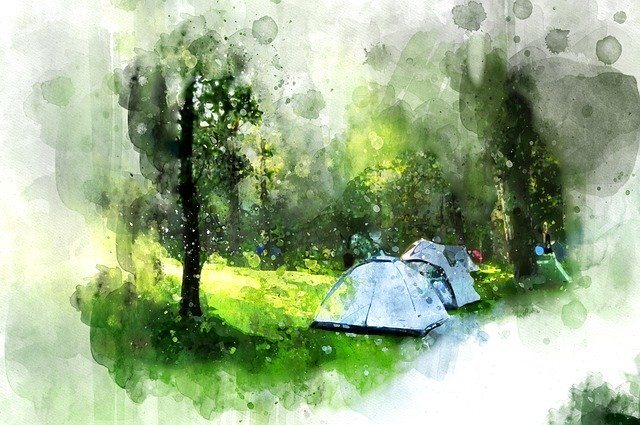
Today I’m going to be discussing the best tents for camping.
With literally thousands of options out there – it can get quite confusing.
Where To Start
If you’re new to camping and sleeping in tents, then you might be thinking that a tent is a tent is a tent…
And you may be technically correct, but practically speaking, there are many types – ranging from quick pop up ones to sturdy little homes away from home that can withstand most of what mother nature can throw at them.
Depends On What You’re Doing
As with most products, what you need really depends on what you’re going to be doing.
If it’s just for a day out at the beach, then a popup tent that is easy to set up and pack away is probably ideal. But if you’re going away for a few nights camping, then you’d probably want something a bit more sturdy.
The other factor to take into account is how you’ll be getting to the campsite and whether you’re hiking between different sites. If you’re driving there and you will be staying at the same place for the duration of your camp, then the weight of the tent probably doesn’t matter too much.
However, if you’re hiking to the campsite and/or hiking between different campsites – then the weight of the tent becomes very important.
Types Of Tents
Ridge/A-frame
This is a classic looking tent that is shaped like an ‘A’.
Traditionally they comprised thick canvas stretched over a horizontal pole supported by a vertical pole at each end. Their stability largely relied upon the guylines and tie-outs, and how well they were placed.
The traditional Scout patrol tents are of this type and are excellent all year round camping tents – the durable materials would ensure the tent lasts for many years and the canvas allows good breathabilty, meaning they are good for summer but also the cold is felt less in a canvas tent, meaning they are good for winter too.
These days, ridge tents use modern materials – lightweight aluminum poles and outer fly sheets made from waterproof polyester or nylon, making them much more lighter to transport.
Ridge tents are remarkably stable and range from tiny one-person tents right up to large marquees. They are easy to pitch and make excellent shelters.
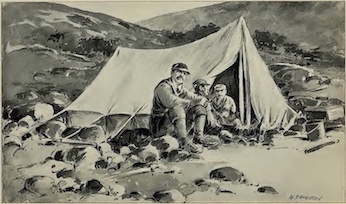
Their main disadvantage is in head height – even in the largest units there’s limited height in most of the tent. This doesn’t matter when you’re using the tent purely for sleeping, but makes it less than ideal for a family holiday in the rain if you can’t walk around inside.
Dome
A simple dome tent has a rectangular floor and two poles which each run from one corner to the diagonally opposite corner, crossing each other at the peak. Dome tents come in a variety of sizes and whereas, the simple ones can sleep one or two people, the more complex designs can sleep 8 or more people and have multiple rooms.
Many dome tents will have a small porch area, and some designs have an extra pole to make the porch space bigger.
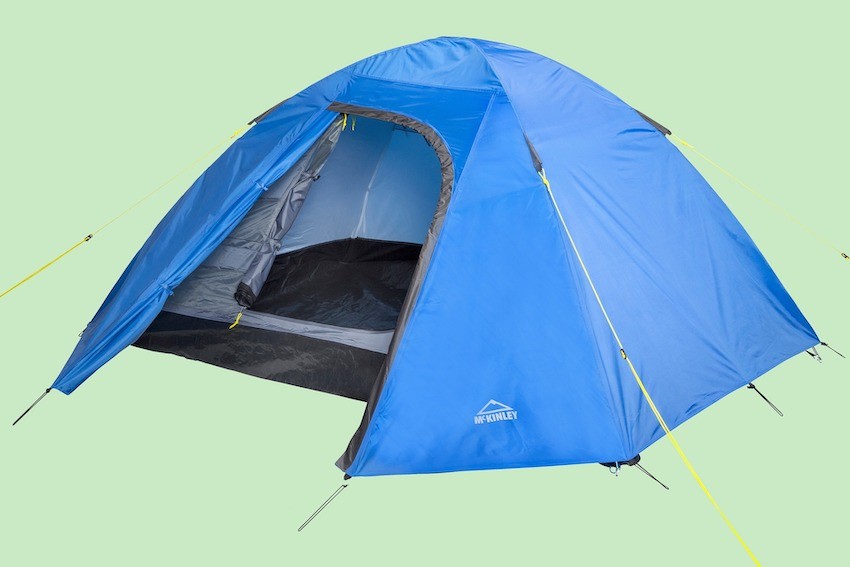
They are quite easy to set up and have a relatively high center point giving you a decent amount of room and headspace. The rounded edges allow the tent to shed water and rain, preventing build up on the top.
The smaller models have fairly good stability, but they become less stable as they scale up in size.
Tunnel
Tunnel tents are made up of a series of flexible poles that loop from one side of the tent to the other to form a tunnel shape for the rainfly to attach to. They rely on guy lines to provide stability, and when put up well they can withstand bad weather reasonably well, especially the bigger models compared with dome tents.
Their stability comes from the tent stakes, guy lines, and pole structure. These tents are almost never freestanding and rely on a large number of attachment points, mainly because of their large size. They have high ceilings and more room than a standard tent, making them a great fit for larger groups of people.
But they are also available in smaller sizes and make a great all year round camping tent.
Disadvantages are that the larger ones are heavy and they don’t deal well with heavy rain – water can pool on top of the rainfly between the poles.
The smaller ones are fine with rain, as there’s not a big flat surface area on top – and some models are quite light for hiking with.
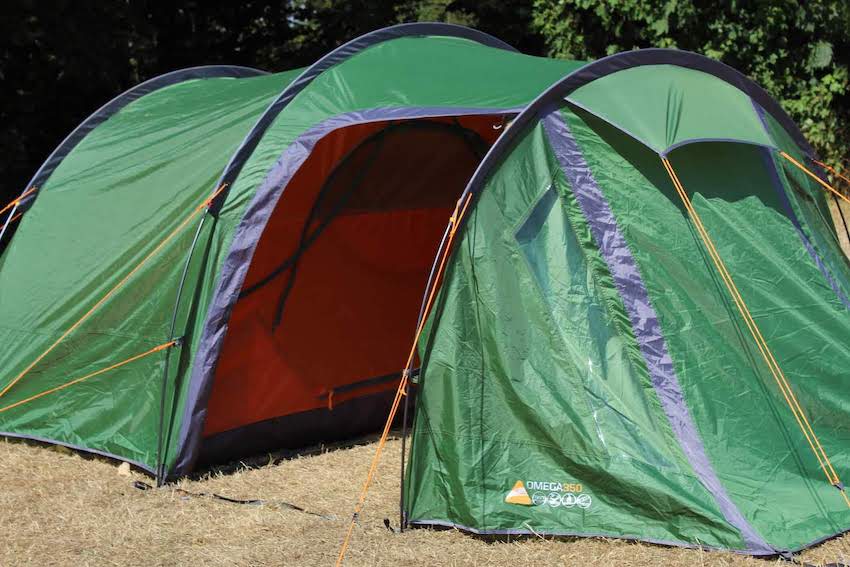
I own a Vango Omega 350 tent, which is a tunnel design and I use it for camping in summer and winter and absolutely love it! You could go backpacking with it, but its 5kg weight would add to your load and there are more lighter options available that would be better suited to hiking.
You can read my review of the Vango Omega 350 tent here:
Vango Omega 350 Review – A Look At This Popular Tent
Geodesic/Semi-geodisic
Geodesic tents are essentially dome tents but with more poles.
The poles crisscross over the surface, intersecting to form triangles. This distributes the stress across the structure, making it the most stable type of tent for extreme weather conditions. If you are going to climb Everest, then you will want to take a geodesic tent with you.
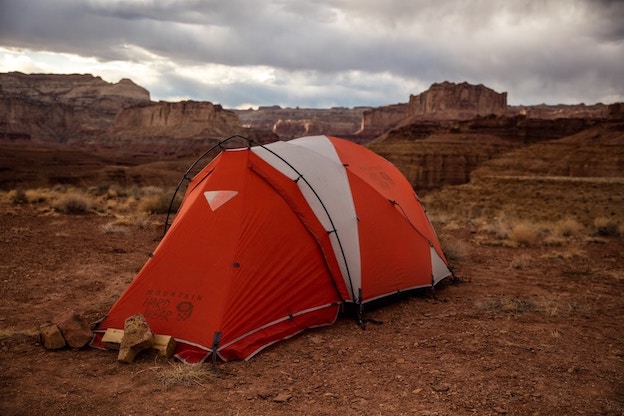
Semi-geodesic tents use similar principles but generally fewer poles for slightly less extreme conditions.
They are normally produced in small sizes for those who are likely to pitch them on mountains or in windy, exposed terrain.
Cabin
Typically cabin tents are made up of aluminium poles that fit together to create a cabin like structure.
A rainfly then covers the frame to form the walls and roof.
This design results in almost vertical walls, allowing you to stand up and move around inside the tent.
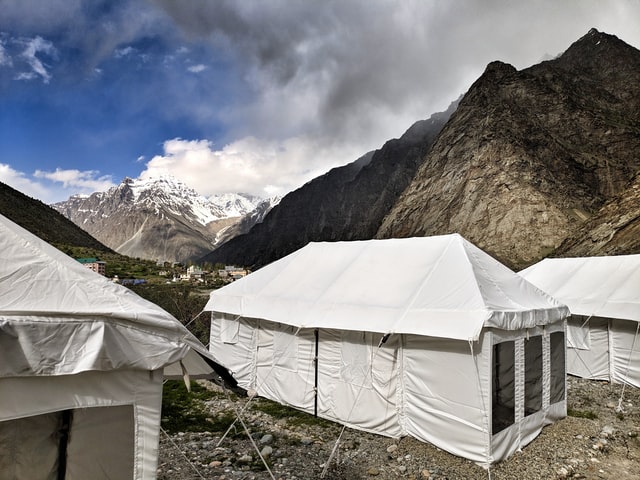
They are great for families and often can be divided into multiple rooms. However, they tend to be quite heavy and, therefore, are only suitable for carrying by car to the campsite.
Many designs would not be suitable for stormy weather, however there are some that can withstand mild winds and rain if they are anchored properly.
Pop Up
Pop up tents are made to be lightweight, convenient, and very quick to set up. They are designed with spring-loaded poles that pop into shape in just a few seconds.
Up until recently I would have said that these tents were really only suitable for good weather conditions, but recent developments have made some much more robust and can sleep up to five people.
However, they are still probably best for just a day out at the beach or a festival.
TeePee/Pyramid
TeePee tents, to most people, bring up memories of the shelters used by Native Americans in the old Western movies.
They are cone shaped tents with a central support and material draped around the center and were traditionally made of thick canvas or hide supported by heavy wooden poles.
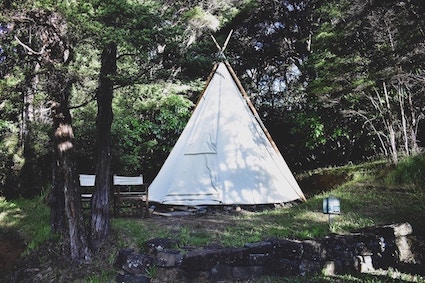
The teepee tents of today are similar in design, however, they are made of modern materials.
There is a central pole acting as the main support, with a rainfly draped over the top and staked down at the edges.
The taller they are the less stable they become.
Best used for fair weather camping or festivals.
Inflatable
Inflatable tents are a relatively new addition to the tent family
Rather than having aluminum or plastic tent poles that hold the tent up, they have air beams that are inflated by a pump to support the tent structure.
They are very quick to set up and take down, but they can be quite heavy.
Although not suited to all camping scenarios, they are a good option for good weather family camping or festivals when minimum pitch time is key.
Backpacking
Backpacking tents are small in size, lightweight, and extremely durable.
They are designed to be carried and lived in for extended periods of time in the middle of nowhere.
So they have to be light, strong and able to withstand almost any weather conditions.
Mostly they’ll be of the Geodesic or tunnel design.
Multi Room
Multi room tents, as the name suggests, are designed to have more than one room.
Many cabin tents come under this category.
They are great for giving added privacy for friends and family.
These tents are significantly larger than your average tent, making them harder to pack and heavier to carry. Pitching these tents takes more practice and more people.
They are perfect for family camping or when camping with a large group.
Many families of 4 will opt for a tent that can accommodate 8 or 10 people to enjoy the extra space and privacy.
Season Ratings
Tents can also be divided into two main season ratings, 3-season and 4-season tents.
3-season tents
These tents are the most common type of tent that you’ll find.
They’re best suited for spring, summer and autumn.
They are designed to protect you from light wind and rain and strive to have adequate ventilation and a durable build while performing well most of the year.
4-season tents
These tents are designed to handle much colder temperatures and to protect you from high winds, extreme cold, and snow.
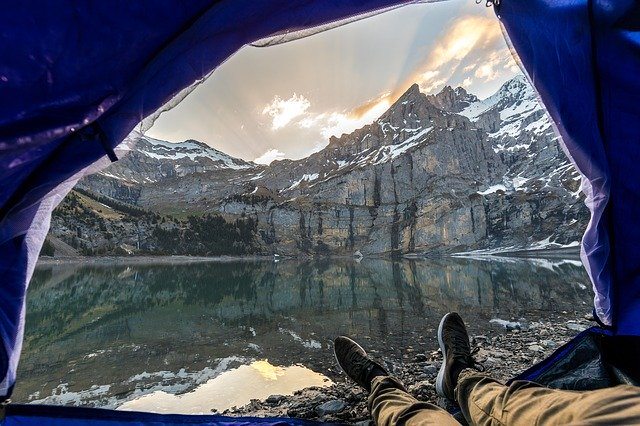
They often have more tent poles, no mesh windows, and have a dome or wedged design that prevents snow from building up.
Despite the four season name, they are really made for winter camping only.
Try camping in one of these in the summer and your tent is going to feel like the inside an oven.
Many 3-season tents will be fine for winter use and can handle light snow just fine, especially if you’re camping below the tree-line.
However, if you’re expecting heavy snow or if you’re planning to camp on a mountain, then you’ll want a 4-season tent to handle the more extreme weather conditions.
So Which One’s For Me?
By now, you should have a decent understanding of the different types of tents that are available.

When deciding which tent to buy, think about what you’ll mainly be using it for and then make your decision based on this.
Camping
If you’ll mainly use it for camping at campsites – where, even in winter, the weather is not extreme – then a good quality 3-season tent would most likely be OK.
If you need it for 3 people or fewer, then a dome or tunnel tent would probably be the best option – I would recommend the Vango Omega 350.
You can read my review of the Vango Omega 350 tent here:
Vango Omega 350 Review – A Look At This Popular Tent
For 4 people or more, depending on whether you need more than 1 room, you could go for an A-frame, tunnel or Cabin/Multi room design.
Hiking
A lightweight backpacking tent would be the best option here.
Mountain climbing/extreme weather camping
Geodesic/Semi-geodisic design
Festivals/day out at the beach
Teepee or pop-up tent
In terms of the size of the tent that you should go for – a general rule of thumb is to minus one person from the manufacturer’s recommendations. So, a two person tent would be comfortable for one with kit, a three person tent, would be comfortable for two with kit and so on.
If weight is not an issue, then you could go with a capacity rated two people higher than the number that will actually be using it – this gives plenty of room for personnel and kit without feeling cramped.

Even within each category, there are many options and variations – read reviews, then make your decision and you should have a tent that will serve you for many years of enjoyable outdoor sleeping and recreation.
I hope that you’ve found this article helpful.
If you have any questions or comments, please leave them below and I’ll try to respond as soon as possible.
Happy tent hunting!
Mohammad


I am currently planning a little camping trip with some of my friends and I’ve been thinking about what kind of tent we need, that can fit us all but also isn’t too expensive. So it was great that I managed to find your article, I think we’re going to go for a tunnel tent. Thanks for the advice.
Glad I could help – let me know how your trip goes… How many of you are going?